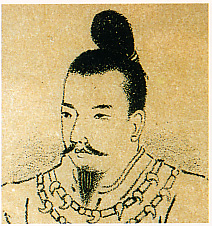Emperor Kōan
Emperor Kōan (孝安天皇, Kōan-tennō) was the 6th emperor of Japan,[1] according to the traditional order of succession.[2] Historians consider Emperor Kōan to be a legendary person;[3] and the name Kōan-tennō was created for him posthumously by later generations.
| Kōan | |
|---|---|
| Emperor of Japan | |
 | |
| Reign | legendary |
| Predecessor | Kōshō |
| Successor | Kōrei |
| Born | legendary |
| Died | legendary |
| Burial | Tamate no oka no e no misasagi (Nara) |
No certain dates can be assigned to this emperor's life or reign.[4] The conventionally accepted names and sequence of the early emperors were not to be confirmed as "traditional" until the reign of Emperor Kammu, who was the 50th monarch of the Yamato dynasty.[5]
The Gukanshō ruled from the palace of Akitsushima-no-miya at Muro in what will come to be known as Yamato province.[6]
Traditional history
changeKōan is almost certainly a legend. The Kojiki records only his name and genealogy. The Nihonshoki includes Kōan as the fifth of "eight undocumented monarchs" (欠史八代,, Kesshi-hachidai).[7]
Emperor Kōan was the second son of Emperor Kōshō.[6] Jinnō Shōtōki records that his mother was Yosotarashi-no-hime, who was the daughter of Okitsuyoso, and ancestress of the Owari.[8]
Events of Kōan's life
changeThe absence of information about Kōan does not imply that no such person ever existed. Very little information is available for study prior to the reign of the 29th monarch, Emperor Kimmei.[9]
After his death
changeThis emperor's official name after his death (his posthumous name) was regularized many centuries after the lifetime which was ascribed to Kōan.[7]
The actual site of his grave is not known. According to the Imperial Household Agency, this emperor is venerated at a memorial Shinto shrine (misasagi) at Nara.[1]
Related pages
changeReferences
change- ↑ 1.0 1.1 Imperial Household Agency (Kunaichō), 孝安天皇 (6); retrieved 2011-10-19.
- ↑ Titsingh, Isaac. (1834). Annales des empereurs du japon, p. 5; Brown, Delmer et al. (1979). Gukanshō, p.252; Varley, Paul. (1980). Jinnō Shōtōki, p. 90; Nussbaum, Louis-Frédéric et al. (2002). "Traditional order of Tennō" in Japan encyclopedia, pp. 962-963.
- ↑ Kelly, Charles F. "Kofun Culture," Japanese Archaeology. April 27, 2009; retrieved 2011-10-19.
- ↑ Ponsonby-Fane, Richard. (1959). The Imperial House of Japan, p. 30.
- ↑ Aston, William George. (1896). Nihongi, pp. 109.
- ↑ 6.0 6.1 Brown, p. 251; Varley, p. 90.
- ↑ 7.0 7.1 Aston, pp. 145-146.
- ↑ Varley, p. 90.
- ↑ Titsingh, pp. 34-36; Brown, pp. 261-262; Varley, pp. 123-124.
| Preceded by Emperor Kōshō |
Legendary Emperor of Japan Kōan 392-291 BC (traditional dates) |
Succeeded by Emperor Kōrei |